Documents: Go to download!
- User Manual - (English, French)
- PARTS AND FEATURES
- USING YOUR REFRIGERATOR
- CARE AND CLEANING
- CONNECTING THE WATER LINE
- TROUBLESHOOTING GUIDE
Table of contents
USER MANUAL
PARTS AND FEATURES
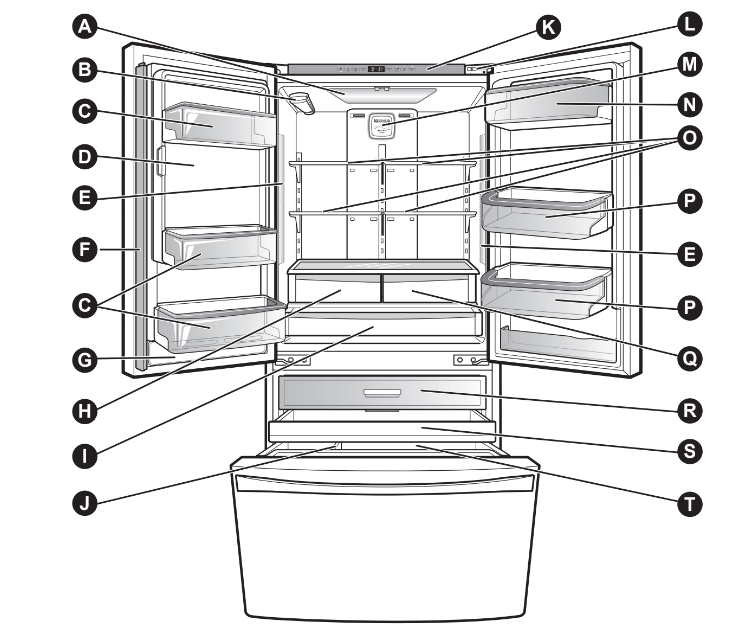
Use this page to become more familiar with the parts and features of your refrigerator.
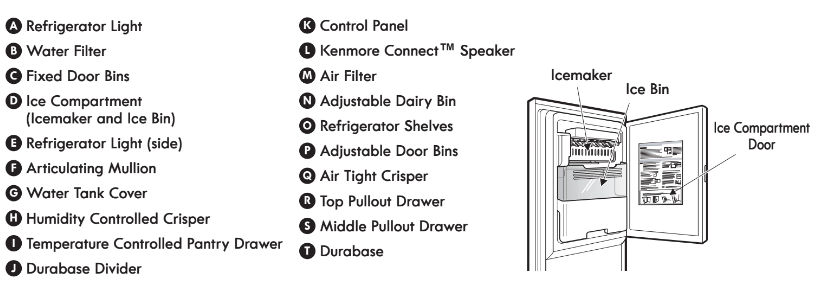
USING YOUR REFRIGERATOR
SETTING THE CONTROLS

- The Refrigerator Temp Control ranges from 33°F to 46°F (1°C to 8°C). Press the refrigerator temp button to cycle through the available temperature settings one increment at a time.
- The Freezer Temp Control range is from -6°F to 8°F (-21°C to -13°C). Press the freezer temp button to cycle through the available temperature settings one increment at a time.
Airflow
Be sure not to block vents while packing your refrigerator.
Doing so will restrict airflow and may cause the refrigerator temperature to become too warm or cause interior moisture buildup. (See air flow diagram below.)
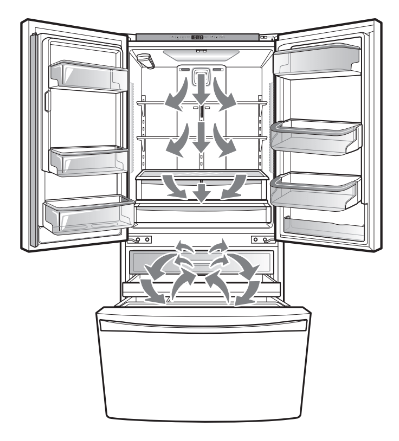
Dispenser
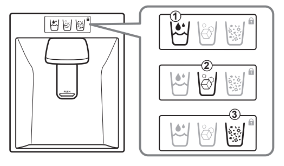
The dispenser will dispense water, cubed ice or crushed ice. Press the appropriate icon of your choice: ( 1 ) water ( 2 ) cubed ice ( 3 ) crushed ice. When pressed the icon will illuminate.
Air Filter 
The Air Filter helps remove odors from the refrigerator. The Air Filter has two settings, Auto and Max. In Auto mode, the Air Filter will cycle on and off in increments of ten minutes on and one hundred and ten minutes off. If set to the Max mode, the Air Filter will stay on continuously for four hours, cycling on and
off in increments of ten minutes on and five minutes off. After four hours, the Air Filter will switch to Auto mode.
• Auto mode is the default mode.
• Press the Air Filter button once for Max mode.
Air Filter Reset 
When the Change icon turns on, the air filter needs to be replaced. After replacing the air filter, press and hold the Air Filter button for three seconds to turn the icon light off. It is recommended to change the air filter approximately every 6 months.
Ice Maker ON/OFF 
To switch the icemaker ON or OFF, press the Ice Maker button.
Ultra Ice 
When you press and hold the Ice Maker button for three seconds, the graphic will illuminate in the display and will continue for 24 hours.
The function will automatically shut off after 24 hours.
Water Filter Reset 
When the Change icon turns on, you need to change the water filter. After changing the water filter, press and hold the Water Filter button for three seconds to turn the indicator light off. You need to change the water filter approximately every six months.
Dispenser Light 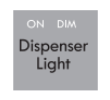
This light has three settings: On, Off and Dim. Select the Dim option at night. The light will automatically turn on at full brightness when the dispenser pad is pushed.
Articulating Mullion
This feature is a metal strip attached to the left door that articulates (rotates) 90 degrees as the door is closed, forming a mullion (base) for the left and right door gaskets to seal against.
Door Alarm 
- When power is connected to the refrigerator, the door alarm is initially set to ON. When you press the Door Alarm button, the display will change to OFF and the Door Alarm function will deactivate.
- When either the refrigerator or the freezer door is left open for more than 60 seconds, the alarm tone will sound to let you know that the door is open.
- When you close the door, the door alarm will stop.
Control Lock 
- When power is initially connected to the refrigerator, the Lock function is off.
- If you want to activate the Lock function to lock other buttons, press and hold the Control Lock button for three seconds or more. The Control Lock button will illuminate and the Lock function is now enabled.
- When the Lock function is activated, no other buttons will work. The dispenser pad is also deactivated.
- To disable the Lock function, press and hold the Control Lock button for approximately three seconds.
Temperature Mode Switch Function (°F <->°C)
If you want to convert °F to °C or vice versa, press and hold the Freezer Temp and Refrigerator Temp buttons at the same time for approximately five seconds.
Demo Mode (For Store Use Only)
The Demo Mode disables all cooling in the refrigerator and freezer sections to conserve energy while on display in a retail store. When activated, OFF will display on the control panel.

To deactivate:
With either refrigerator door opened, press and hold the Refrigerator Temp and Ice Maker buttons at the same time for five seconds. The control panel will beep and the temperature settings will display to confirm that Demo Mode is deactivated. Use the same procedure to activate the Demo Mode.
IN-DOOR ICE BIN
1.Pull or push the door handle to open or close the ice compartment.
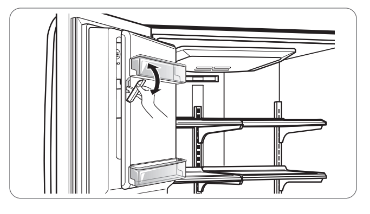
2.To remove the in-door ice bin, grip the front handle, slightly lift the lower part, and slowly pull out the bin as shown.
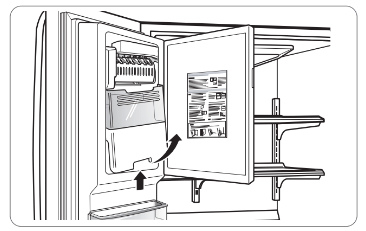
3.To reinstall the in-door ice bin, slightly slant the bin during replacement to avoid contact with the icemaker.
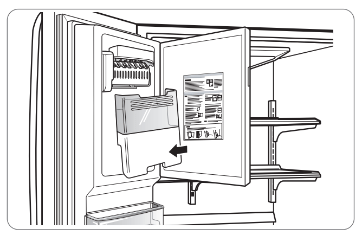
4.Avoid touching the auto shutoff (feeler arm) when replacing the ice bin. See the label on the ice compartment door for details.

AUTOMATIC ICEMAKER
Ice is made in the automatic icemaker and sent to the dispenser. The icemaker will produce 70-182 cubes in a 24-hour period, depending on freezer compartment temperature, room temperature, number of door openings and other operating conditions.
- It takes about 12 to 24 hours for a newly installed refrigerator to begin making ice. Wait 72 hours for full ice production to occur.
- Ice making stops when the in-door ice bin is full. When full, the in-door ice bin holds approximately 6 to oz or 340-455 cc) glasses of ice.
- Foreign substances or frost on the auto shutoff (feeler arm) can interrupt ice production. Make sure the feeler arm is clean at all times for proper operation.
- To increase ice production, use the Ultra Ice function. This function increases both ice making and freezing capabilities.
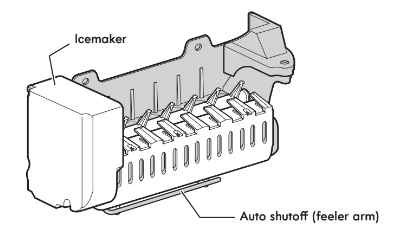
WHEN TO SET ICEMAKER TO OFF
- When the water supply will be shut off for several hours.
- When the ice bin is removed for more than one or two minutes.
- When the refrigerator will not be used for several days.
NORMAL SOUNDS YOU MAY HEAR
- If the icemaker ON/OFF button is set to ON, the valve will buzz even if the icemaker has not het been hooked up to water. To stop the buzzing, switch the button to OFF.
- You will hear the sound of cubes dropping into the bin and water running in the pipes as the icemaker refills.
REFRIGERATOR SECTION
WATER DISPENSER
To dispense cold water, push on the dispenser switch with a glass.
NOTE: The dispenser is equipped with a light that turns on when the dispenser pad is engaged.
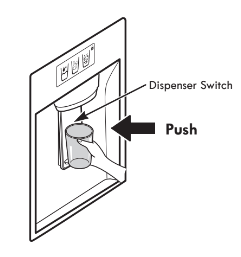
Some dripping may occur after dispensing. Hold your cup beneath the dispenser for a few seconds after dispensing to catch all of the drops.
REFRIGERATOR SHELVES
The shelves in your refrigerator are adjustable to meet your individual storage needs. Your model may have glass or wire shelves.
Adjusting the shelves to fit different heights of items will make finding the exact item you want easier. Doing so will also reduce the amount of time the refrigerator door is open which will save energy.
Adjusting Shelves (Cantilever)
Remove shelves from the shipping position and replace shelves in the position you want.
To remove a shelf—Tilt up the front of the shelf in the direction of 1 and lift it in the direction of 2 . Pull the shelf out.

To reinstall a shelf—Tilt the front of the shelf up and guide the shelf hooks into the slots at a desired height. Then, lower the front of the shelf so that the hooks drop into the slots.
Folding Shelf (on some models)
You can store taller items, such as a gallon container or bottles, by simply pushing the front half of the shelf underneath the back half of the shelf. Pull the front of the shelf toward you to return to a full shelf.

HUMIDITY CONTROLLED CRISPER
The crispers provide fresher tasting fruit and vegetables by letting you easily control humidity inside the drawer.
You can control the amount of humidity in the moisture- sealed crispers by adjusting the control to any setting between VEGETABLES and FRUIT.
- VEGETABLES keeps moist air in the crisper for best storage of fresh, leafy vegetables.
- FRUIT lets moist air out of the crisper for best storage of fruit.
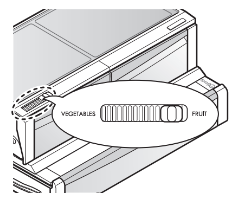
REMOVING THE HUMIDITY CONTROLLED CRISPER
1. To remove, pull the drawer out to full extension.
2. Lift the front of the crisper up, then pull it straight out.
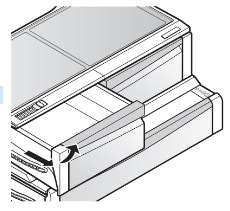
3. To install, slightly tilt up the front, insert the drawer into the frame and push it back into place.
To remove the glass
- Lift up the glass under the crisper cover.
- Pull the glass up and out.
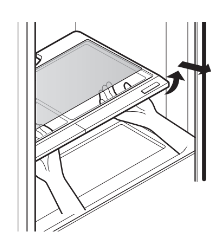
NOTE: Pantry drawer not shown for clarity.
TEMPERATURE CONTROLLED PANTRY DRAWER
The Temperature Controlled Pantry Drawer provides storage space with a variable temperature control that can keep the compartment at a slightly different temperature than the refrigerator section. This drawer can be used for large party trays, deli items and beverages. (This drawer should not be used for vegetables that require high humidity.)
Press the button to choose between Meat (Coldest), Deli Colder) and Produce (Cold).

DOOR BIN
The door bins are removable for easy cleaning and adjustment.
- To remove the bin, simply lift the bin up and pull straight out.
- To replace the bin, slide it in above the desired support and push down until it snaps into place.

REPLACING THE AIR FILTER
It is recommended that you replace the air filter:
- Approximately every six months.
- When the CHANGE AIR FILTER light turns on.

1.Remove the Old Filter
Turn the filter cover to the left to detach it from the refrigerator wall. The filter is located on the inside of the filter cover. Remove the filter from the cover and replace it with a new filter.
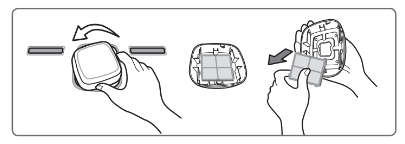
2.Install a New Air Filter.
Place the new filter inside of the cover with the side that says “Front” facing outward. Turn the filter cover to the right to attach it to the refrigerator wall.

After changing the filter, push and hold the Air Filter button for three seconds to reset the filter sensor.
FREEZER SECTION
EXTRA ICE BIN
- Pull the Freezer Drawer and the top Pullout Drawer out as far as possible to remove the Extra Ice Bin.
- Gently lift and pull out the ice bin.
- To replace, pull both drawers out as far as possible, and set the bin in its correct position in the Pullout Drawer. Close the Pullout Drawer and then the Freezer Drawer.

PULLOUT DRAWERS
Top Drawer
- To remove, pull the drawer out to full extension. On the left rail, use a flat blade screwdriver to push in on the tab to release the drawer from the rail, as shown below. Once the left side is loose, push the tab on the right side with your finger to release the drawer. Lift the front of the drawer up, then pull it straight out.

2.To replace, slightly tilt up the front of the drawer, insert the drawer into the frame, and push the drawer back into place until you hear a click.

Middle Drawer
1.To remove, pull the drawer out to full extension. Lift the front of the drawer up, then pull it straight out.
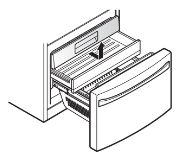
2.To replace, slightly tilt up the front of the drawer, insert the drawer into the frame, and push it back into place.
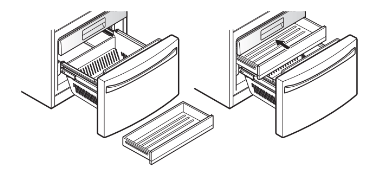
DURABASE
- To remove the Durabase, push it to the back as much as possible. Tilt up the front of the Durabase and pull straight out.
- To replace, insert the Durabase in the rail assembly.

DURABASE DIVIDER
The Durabase divider allows you to organize the Durabase area into sections. It can be adjusted from side to side to accommodate items of different sizes.

CARE AND CLEANING
Both the refrigerator and freezer sections defrost automatically; however, clean both sections about once a month to prevent odors. Wipe up spills immediately.
GENERAL CLEANING TIPS
• Unplug refrigerator or disconnect power.
• Remove all removable parts, such as shelves, crispers,
etc. Refer to sections in Using Your Refrigerator for removal instructions.
• Use a clean sponge or soft cloth and a mild detergent
in warm water. Do not use abrasive or harsh cleaners.
• Hand wash , rinse and dry all surfaces thoroughly.
• Plug in refrigerator or reconect power
EXTERIOR
Waxing external painted metal surfaces helps provide rust protection. Do not wax plastic parts. Wax painted metal surfaces at least twice a year using appliance wax (or auto paste wax). Apply wax with a clean, soft cloth.
For products with a stainless steel exterior, use a clean sponge or soft cloth and a mild detergent in warm water.
Do not use abrasive or harsh cleaners. Dry thoroughly with a soft cloth.
INSIDE WALLS (allow freezer to warm up so the cloth will not stick)
To help remove odors, you can wash the inside of the refrigerator with a mixture of baking soda and warm water. Mix 2 tablespoons of baking soda to 1 quart of water (26 g soda to 1 liter water.) Be sure the baking soda is completely dissolved so it does not scratch the surfaces of the refrigerator.
DOOR LINERS AND GASKETS
Use a clean sponge or soft cloth and a mild detergent in warm water. Do not use cleaning waxes, concentrated detergents, bleaches, or cleaners containing petroleum on plastic refrigerator parts.
PLASTIC PARTS (Covers and Panels)
Use a clean sponge or soft cloth and a mild detergen in warm water. Do not use window sprays, abrasive cleansers, or flammable fluids. These can scratch or damage the material.
CONDENSER COILS
Use a vacuum cleaner with an attachment to clean the condenser cover and vents. Do not remove the panel covering the condenser coil area.
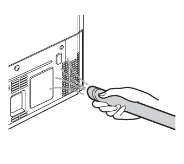
POWER INTERRUPTIONS
1. If the power will be out for 24 hours or less, keep all refrigerator doors closed to help foods stay cold and frozen.
2. If the power will be out for more than 24 hours, remove all frozen food and store it in a frozen food locker.
WHEN YOU GO ON VACATION
If you choose to leave the refrigerator on while you are away, follow these steps to prepare your refrigerator before you leave.
1. Use up any perishables and freeze other items.
2. Turn off the icemaker and empty the ice bin.
If you choose to turn the refrigerator off before you leave, follow these steps.
1. Remove all food from the refrigerator.
2. Depending on your model, set the thermostat control (refrigerator control) to OFF. See the Setting the Controls section.
3. Clean the refrigerator, wipe it and dry well.
4. Tape rubber or wood blocks to the tops of both doors to prop them open far enough for air to get in. This stops odor and mold from building up.
WHEN YOU MOVE
When you are moving your refrigerator to a new home,
follow these steps to prepare it for the move.
1. Remove all food from the refrigerator and pack all frozen food in dry ice.
2. Unplug the refrigerator.
3. Clean, wipe and dry thoroughly.
4. Take out all removable parts, wrap them well and tape them together so they do not shift and rattle during the move. Refer to the Using your Refrigerator section for removable instructions.
5. Depending on the model, raise the front of the refrigerator so it rolls easier OR screw in the leveling legs all the way so they do not scrape the floor. See the Door Closing section.
6. Tape the doors shut and tape the power cord to the
refrigerator cabinet.
When you get to your new home, put everything back and
refer to the Refrigerator Installation section for preparation
instructions.
CONNECTING THE WATER LINE
BEFORE YOU BEGIN
This water line installation is not covered by the refrigerator
warranty. Follow these instructions carefully to minimize the
risk of expensive water damage.
Water hammer (water banging in the pipes) in house
plumbing can cause damage to refrigerator parts and can
lead to water leakage or flooding. Call a qualified plumber
to correct water hammer before installing the water supply
line to the refrigerator.
WATER PRESSURE
A cold water supply. The water pressure must be between
20 and 120 psi. If the refrigerator is installed in an area
with low water pressure (below 20 psi), you can install a
booster pump to compensate for the low pressure.
If a reverse osmosis water filtration system is connected
to your cold water supply, this water line installation is not
covered by the refrigerator warranty. Follow the following
instructions carefully to minimize the risk of expensive water
damage.
If a reverse osmosis water filtration system is connected
to your cold water supply, the water pressure to the
reverse osmosis system needs to be a minimum of 40 to
60 psi (276-414 kPa or 2.8-4.2 kgf/cm2, less than 2.0-3.0
sec. to fill a cup of 7 oz or 198 cc capacity).
If the water pressure from the reverse osmosis system is less
than 20 psi or 138 kPa or 1.4 kgf/cm2 (takes more than 4.0
sec to fill a cup of 7 oz or 198 cc capacity):
• Check to see if the sediment filter in the reverse osmosis
system is blocked. Replace the filter if necessary.
• Allow the storage tank on the reverse osmosis system to
refill after heavy usage.
• If the issue concerning water pressure from reverse
osmosis remains, call a licensed, qualified plumber.
• All installations must be in accordance with local
plumbing code requirements.
WHAT YOU WILL NEED
• Copper Tubing, 1⁄4 in. outer diameter, to connect the refrigerator to the water supply. Be sure both ends of the tubing are cut square.
• To determine how much tubing you need: measure the distance from the water valve on the back of the refrigerator to the water supply pipe. Then, add 8 feet (2.4 m). Be sure there is sufficient extra tubing (about 8 feet [2.4 m] coiled into 3 turns of about 10 in. [25 cm] diameter) to allow the refrigerator to move out from the wall after installation.

• Power drill.
• 1⁄2 in. or adjustable wrench.
• Flat blade and Phillips head screwdrivers.
• Two 1⁄4 in. outer diameter compression nuts and 2 ferrules (sleeves) to connect the copper tubing to the shutoff valve and the refrigerator water valve.

• If your existing copper water line has a flared fitting at the
end, you will need an adapter (available at plumbing supply
stores) to connect the water line to the refrigerator OR you can
cut off the flared fitting with a tube cutter and then use a compression fitting.

• Shutoff valve to connect to the cold water line. The shutoff valve should have a water inlet with a minimum inside diameter of 5/32 in. at the point of connection to the COLD WATER LINE.
Saddle-type shutoff valves are included in many water
supply kits. Before purchasing, make sure a saddle-type
valve complies with your local plumbing codes.
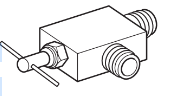
INSTALLATION INSTRUCTIONS
Install the shutoff valve on the nearest frequently used drinking water line.
1. SHUT OFF THE MAIN WATER SUPPLY
Turn on the nearest faucet to relieve the pressure on the line.
2. CHOOSE THE VALVE LOCATION
Choose a location for the valve that is easily accessible. It is best to connect into the side of a vertical water pipe.
When it is necessary to connect into a horizontal water pipe, make the connection to the top or side, rather than at the bottom, to avoid drawing off any sediment from the water pipe.

3. DRILL THE HOLE FOR THE VALVE
Drill a 1⁄4 in. hole in the water pipe using a sharp bit.
Remove any burrs resulting from drilling the hole in the pipe. Be careful not to allow water to drain into the drill. Failure to drill a 1⁄4 in. hole may result in reduced ice production or smaller cubes.
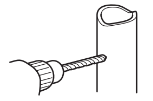
4. FASTEN THE SHUTOFF VALVE
Fasten the shutoff valve to the cold water pipe with the pipe clamp.
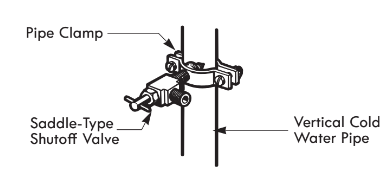
5. TIGHTEN THE PIPE CLAMP
Tighten the clamp screws until the sealing washer begins to swell.

6. ROUTE THE TUBING
Route the tubing between the cold water line and the refrigerator.
Route the tubing through a hole drilled in the wall or floor (behind the refrigerator or adjacent base cabinet) as close to the wall as possible.
7. CONNECT THE TUBING TO THE VALVE
Place the compression nut and ferrule (sleeve) for copper tubing onto the end of the tubing and connect it to the shutoff valve. Make sure the tubing is fully inserted into the valve. Tighten the compression nut securely.
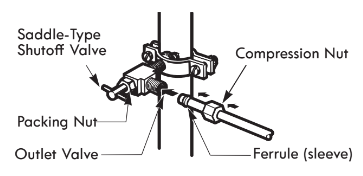
8. FLUSH OUT THE TUBING
Turn the main water supply on and flush out the tubing until the water is clear.
Shut the water off at the water valve after about one quart of
water has been flushed through the tubing.
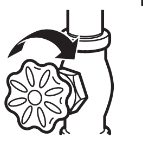
9. CONNECT THE TUBING TO THE REFRIGERATOR
1. Remove the plastic flexible cap from the water valve.
2. Place the compression nut and ferrule (sleeve) onto the
end of the tubing as shown.
3. Insert the end of the copper tubing into the connection
as far as possible. While holding the tubing, tighten the
fitting.

10. TURN THE WATER ON AT THE SHUTOFF VALVE
Tighten any connections that leak.

11. PLUG IN THE REFRIGERATOR
Arrange the coil of tubing so that it does not vibrate against the back of the refrigerator or against the wall. Push the refrigerator back to the wall.

12. START THE ICEMAKER
Turn the icemaker ON at the control panel. The icemaker will not begin to operate until it reaches its operating temperature of 15°F (–9°C) or below. It will then begin operation automatically if the icemaker button has been turned ON.
TROUBLESHOOTING GUIDE
Before conducting troubleshooting, make sure that the following basic requirements are met:
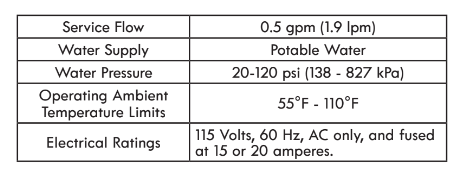
COOLING
| Problem | Possible Causes | Solutions |
| Refrigerator and Freezer section are not cooling. | The refrigerator control is set to OFF (some models). | Turn the control ON. Refer to the Setting the Controls section for proper temperature settings. |
| Refrigerator is set to demo mode. | Demo Mode allows the lights and control display to work normally while disabling cooling to save energy while on the showroom floor. Refer to the Setting the Controls section for instructions on how to disable Demo Mode. | |
| Refrigerator is in the defrost cycle. | During the defrost cycle, the temperature of each compartment may raise slightly. Wait 30 minutes and confirm the proper temperature has been restored once the defrost cycle has completed. | |
| Refrigerator was recently installed. | It may take up to 24 hours for each compartment to reach the desired temperature. | |
| Refrigerator was recently relocated. | If the refrigerator was stored for a long period of time or moved on its side, it is necessary for the refrigerator to stand upright for 24 hours before connecting it to power. | |
| Cooling System runs too much. | Refrigerator is replacing an older model. | Modern refrigerators require more operating time but use less energy due to more efficient technology. |
| Refrigerator was recently plugged in or power restored. | The refrigerator will take up to 24 hours to cool completely. | |
| Door opened often or a large amount of food / hot food was added. | Adding food and opening the door warms the refrigerator, requiring the compressor to run longer in order to cool the refrigerator back down. In order to conserve energy, try to get everything you need out of the refrigerator at once, keep food organized so it is easy to find, and close the door as soon as the food is removed. (Refer to the Food Storage Guide.) | |
| Doors are not closed completely. | Firmly push the doors shut. If they will not shut all the way, see the Doors will not close completely or pop open section in Parts & Features Troubleshooting. | |
| Refrigerator is installed in a hot location. | The compressor will run longer under warm conditions. At normal room temperatures (70°F) expect your compressor to run about 40% to 80% of the time. Under warmer conditions, expect it to run even more often. The refrigerator should not be operated above 110°F. | |
| Condenser / back cover is clogged. | Use a vacuum cleaner with an attachment to clean the condenser cover and vents. Do not remove the panel covering the condenser coil area. | |
| Refrigerator or Freezer section is too warm. | Refrigerator was recently installed. | It may take up to 24 hours for each compartment to reach the desired temperature. |
| Air vents are blocked. | Rearrange items to allow air to flow throughout the compartment. Refer to the Airflow diagram in the Using Your Refrigerator section. | |
| Doors are opened often or for long periods of time. | When the doors are opened often or for long periods of time, warm, humid air enters the compartment. This raises the temperature and moisture level within the compartment. To lessen the effect, reduce the frequency and duration of door openings. | |
| Unit is installed in a hot location. | The refrigerator should not be operated in temperatures above 110F. | |
| A large amount of food or hot food was added to either compartment. | Adding food warms the compartment requiring the cooling system to run. Allowing hot food to cool to room temperature before putting it in the refrigerator will reduce this effect. | |
| Doors not closed correctly. | See the Doors will not close correctly or pop open section in Parts & Features Troubleshooting. | |
| Temperature control is not set correctly. | If the temperature is too warm, adjust the control one increment at a time and wait for the temperature to stabilize. Refer to the Setting the Controls section for more information. | |
| Defrost cycle has recently completed. | During the defrost cycle, the temperature of each compartment may raise slightly and condensation may form on the back wall. Wait 30 minutes and confirm the proper temperature has been restored once the defrost cycle has completed. | |
| Interior moisture buildup. | Doors are opened often or for long periods of time. | When the doors are opened often or for long periods of time, warm, humid air enters the compartment. This raises the temperature and moisture level within the compartment. To lessen the effect, reduce the frequency and duration of door openings. |
| Doors not closed correctly. | See the Doors will not close correctly section in the Troubleshooting section. | |
| Weather is humid. | Humid weather allows additional moisture to enter the compartments when the doors are opened leading to condensation or frost. Maintaining a reasonable level of humidity in the home will help to control the amount of moisture that can enter the compartments. | |
| Defrost cycle recently completed. | During the defrost cycle, the temperature of each compartment may raise slightly and condensation may form on the back wall. Wait 30 minutes and confirm that the proper temperature has been restored once the defrost cycle has completed. | |
| Food is not packaged correctly. | Food stored uncovered or unwrapped, and damp containers can lead to moisture accumulation within each compartment. Wipe all containers dry and store food in sealed packaging to prevent condensation and frost. |
COOLING/ICE & WATER
| Problem | Possible Causes | Solutions |
| Food is freezing in the refrigerator compartment. | Food with high water content was placed near an air vent. | Rearrange items with high water content away from air vents. |
| Refrigerator temperature control is set incorrectly. | If the temperature is too cold, adjust the control one increment at a time and wait for the temperature to stabilize. Refer to the Setting the Controls section for more information. | |
| Refrigerator is installed in a cold location. | When the refrigerator is operated in temperature below 41°F (5°C), food can freeze in the refrigerator compartment. The refrigerator should not be operated in temperature below 55°F (13°C). | |
| Frost or ice crystals form on frozen food (outside of package). | Door is opened frequently or for long periods of time. | When the doors are opened often or for long periods of time, warm, humid air enters the compartment. This raises the temperature and moisture level within the compartment. Increased moisture will lead to frost and condensation. To lessen the effect, reduce the frequency and duration of door openings. |
| Door is not closing properly. | Refer to the Doors will not close correctly or pop open section in the Troubleshooting section. | |
| Refrigerator or Freezer section is too cold. | Incorrect temperature control settings. | If the temperature is too cold, adjust the control one increment at a time and wait for the temperature to stabilize. Refer to the Setting the Controls section for more information. |
| Frost or ice crystals on frozen food (inside of sealed package). | Condensation from food with a high water content has frozen inside of the food package. | This is normal for food items with a high water content. |
| Food has been left in the freezer for a long period of time. | Do not store food items with high water content in the freezer for a long period of time. | |
| Icemaker is not making enough ice. | Demand exceeds ice storage capacity. | The icemaker will produce approximately 70-182 cubes in a 24 hour period. |
| House water supply is not connected, valve is not turned on fully, or valve is clogged. | Connect the refrigerator to a cold water supply with adequate pressure and turn the water shutoff valve fully open. If the problem persists, it may be necessary to contact a plumber. | |
| Water filter has been exhausted. | It is recommended that you replace the water filter: • When the water filter indicator turns on. • When the water dispenser output decreases. • When the ice cubes are smaller than normal. | |
| Low house water supply pressure. | The water pressure must be between 20 and 120 psi on models without a water filter and between 40 and 120 psi on models with a water filter. If the problem persists, it may be necessary to contact a plumber or install a booster pump to compensate for the low pressure. | |
| Reverse Osmosis filtration system is used. | Reverse osmosis filtration systems can reduce the water pressure below the minimum amount and result in icemaker issues. (Refer to Water Pressure section.) | |
| Tubing connecting refrigerator to house supply valve is kinked. | The tubing can kink when the refrigerator is moved during installation or cleaning resulting in reduced water flow. Straighten or repair the water supply line and arrange it to prevent future kinks. | |
| Doors are opened often or for long periods of time. | If the doors of the unit are opened often, ambient air will warm the refrigerator which will prevent the unit from maintaining the set temperature. Lowering the refrigerator temperature can help, as well as not opening the doors as frequently. | |
| Doors are not closed completely. | If the doors are not properly closed, ice production will be affected. See the Doors will not close completely or pop open section in Parts & Features Troubleshooting for more information. | |
| The temperature setting for the freezer is too warm. | The recommended temperature for the freezer compartment for normal ice production is 0°F. If the freezer temperature is warmer, ice production will be affected. | |
| Dispensing water slowly. | Water filter has been exhausted. | It is recommended that you replace the water filter: • When the water filter indicator turns on. • When the water dispenser output decreases. • When the ice cubes are smaller than normal. |
| Reverse osmosis filtration system is used. | Reverse osmosis filtration systems can reduce the water pressure below the minimum amount and result in icemaker issues. If the problem persists, it may be necessary to contact a plumber or install a booster pump to compensate for the low pressure. | |
| Low house water supply pressure. | The water pressure must be between 20 and 120 psi on models without a water filter and between 40 and 120 psi on models with a water filter. If the problem persists, it may be necessary to contact a plumber or install a booster pump to compensate for the low pressure. | |
| Not dispensing ice. | Doors are not closed completely. | Ice will not dispense if any of the refrigerator doors are left open. |
| Infrequent use of the dispenser. | Infrequent use of the ice dispenser will cause the cubes to stick together over time, which will prevent them from properly dispensing. Check the ice bin for ice cubes clumping/sticking together. If they are, break up the ice cubes to allow for proper operation. | |
| The delivery chute is clogged with frost or ice fragments. | Eliminate the frost or ice fragments by removing the ice bin and clearing the chute with a plastic utensil. Dispensing cubed ice can also help prevent frost or ice fragment buildup. | |
| The dispenser display is locked. | Press and hold the Lock button for three seconds to unlock the control panel and dispenser. | |
| Ice bin is empty. | It may take up to 24 hours for each compartment to reach the desired temperature and for the icemaker to begin making ice. Make sure that the shutoff (arm/ sensor) is not obstructed. Once the ice supply in the bin has been completely exhausted, it my take up to 90 minutes before additional ice is available, and approximately 24 hours to completely refill the bin. |
ICE & WATER
| Problem | Possible Causes | Solutions |
| Icemaker is not making ice. | Refrigerator was recently installed or icemaker recently connected. | It may take up to 24 hours for each compartment to reach the desired temperature and for the icemaker to begin making ice. |
| Icemaker not turned on. | Locate the icemaker on/off button and confirm that it is turned ON. | |
| The refrigerator is not connected to a water supply or the supply shutoff valve is not turned on. | Connect refrigerator to the water supply and turn the water shutoff valve fully open. | |
| Icemaker shutoff (feeler arm) obstructed. | If your icemaker is equipped with an ice shutoff arm, make sure that the arm moves freely. | |
| Reverse osmosis water filtration ·system is connected to your cold water supply. | Reverse osmosis filtration systems can reduce the water pressure below the minimum amount and result in icemaker issues. (Refer to the Water Pressure section.) | |
| Not dispensing water. | New installation or water line recently connected. | Dispense 2.5 gallons of water (flush for approximately 5 minutes) to remove trapped air and contaminates from the system. Do not dispense the entire 2.5 gallon amount continuously. Depress and release the dispenser pad for cycles of 30 seconds ON and 60 seconds OFF. |
| The dispenser panel is locked. | Press and hold the Lock button for three seconds to unlock the control panel and dispenser. | |
| The dispenser is not set for water dispensing. | The dispenser can be set for ice or water. Make certain that the control panel is set for the proper operation. Press the Water button on the control panel to dispense water. | |
| Refrigerator or freezer doors are not closed properly. | Water will not dispense if any of the refrigerator doors are left open. | |
| Water filter has been recently removed or replaced. | After the water filter is replaced, dispense 2.5 gallons of water (flush for approximately 5 minutes) to remove trapped air and contaminates from the system. Do not dispense the entire 2.5 gallon amount continuously. Depress and release the dispenser pad for cycles of 30 seconds ON and 60 seconds OFF. | |
| Tubing connecting refrigerator to house supply valve is kinked. | The tubing can kink when the refrigerator is moved during installation or cleaning resulting in reduced water flow. Straighten or repair the water supply line and arrange it to prevent future kinks. | |
| The house water supply is not connected, the valve is not turned on fully, or the valve is clogged. | Connect refrigerator to the water supply and turn the water shutoff valve fully open. If the problem persists, it may be necessary to contact a plumber. | |
| Ice has bad taste or odor. | Water supply contains minerals such as sulfur. | A water filter may need to be installed to eliminate taste and odor problems. |
| Icemaker was recently installed. | Discard the first few batches of ice to avoid discolored or bad tasting ice. | |
| Ice has been stored for too long. | Ice that has been stored for too long will shrink, become cloudy, and may develop a stale taste. Throw away old ice and make a new supply. | |
| The food has not been stored properly in either compartment. | Rewrap the food. Odors may migrate to the ice if food is not wrapped properly. | |
| The interior of the refrigerator needs to be cleaned. | See the Care and Cleaning section for more information. | |
| The ice storage bin needs to be cleaned. | Empty and wash the bin (discard old cubes). Make sure that the bin is completely dry before reinstalling it. | |
| Dispensing warm water. | Refrigerator was recently installed. | Allow 24 hours after installation for the water storage tank to cool completely. |
| The water dispenser has been used recently and the storage tank was exhausted. | Depending on your specific model, the water storage capacity will range from approximately 20 to 30 oz. | |
| Dispenser has not been used for several hours. | If the dispenser has not been used for several hours, the first glass dispensed may be warm. Discard the first 10 oz. | |
| Refrigerator is connected to the hot water supply. | Make sure that the refrigerator is connected to a cold water pipe. | |
| Water has bad taste or odor. | Water supply contains minerals such as sulfur. | A water filter may need to be installed to eliminate taste and odor problems. |
| Water filter has been exhausted. | It is recommended that you replace the water filter: • When the water filter indicator turns on. • When the water dispenser output decreases. • When the ice cubes are smaller than normal. | |
| Refrigerator was recently installed. | Dispense 2.5 gallons of water (flush for approximately 5 minutes) to remove trapped air and contaminates from the system. Do not dispense the entire 2.5 gallon amount continuously. Depress and release the dispenser pad for cycles of 30 seconds ON and 60 seconds OFF. | |
| Icemaker is making too much ice. | Icemaker shutoff (feeler arm) is obstructed. | Empty the ice bin. If your icemaker is equipped with an ice shutoff arm, make sure that the arm moves freely. Reinstall the ice bin and wait 24 hours to confirm proper operation. |
NOISE
| Problem | Possible Causes | Solutions |
| Clicking | The defrost control will click when the automatic defrost cycle begins and ends. The thermostat control (or refrigerator control on some models) will also click when cycling on and off. | Normal Operation |
| Rattling | Rattling noises may come from the flow of refrigerant, the water line on the back of the unit, or items stored on top of or around the refrigerator. | Normal Operation |
| Refrigerator is not resting solidly on the floor. | Floor is weak or uneven or leveling legs need to be adjusted. See the Door Alignment section. | |
| Refrigerator with linear compressor was jarred while running. | Normal Operation | |
| Whooshing | Evaporator fan motor is circulating air through the refrigerator and freezer compartments. | Normal Operation |
| Air is being forced over the condenser by the condenser fan. | Normal Operation | |
| Gurgling | Refrigerant flowing through the cooling system. | Normal Operation |
| Popping | Contraction and expansion of the inside walls due to changes in temperature. | Normal Operation |
| Sizzling | Water dripping on the defrost heater during a defrost cycle. | Normal Operation |
| Vibrating | If the side or back of the refrigerator is touching a cabinet or wall, some of the normal vibrations may make an audible sound. | To eliminate the noise, make sure that the sides and back cannot vibrate against any wall or cabinet. |
| Dripping | Water running into the drain pan during the defrost cycle. | Normal Operation |
| Pulsating or High- Pitched Sound | Your refrigerator is designed to run more efficiently to keep your food items at the desired temperature. The high efficiency compressor may cause your new refrigerator to run longer than your old one, but it is still more energy efficient than previous models. While the refrigerator is running, it is normal to hear a pulsating or high- pitched sound. | Normal Operation |
PARTS & FEATURES
| Problem | Possible Causes | Solutions |
| Doors will not close correctly or pop open. | Food packages are blocking the door open. | Rearrange food containers to clear the door and door shelves. |
| Ice bin, crisper cover, pans, shelves, door bins, or baskets are out of position. | Push bins all the way in and put crisper cover, pans, shelves and baskets into their correct positions. See the Using Your Refrigerator section for more information. | |
| The doors were removed during product installation and not properly replaced. | Remove and replace the doors according to the Removing and Replacing Refrigerator Handles and Doors section. | |
| Refrigerator is not leveled properly. | See Door Alignment in the Refrigeration Installation section to level refrigerator. | |
| Doors are difficult to open. | The gaskets are dirty or sticky. | Clean the gaskets and the surfaces that they touch. Rub a thin coat of appliance polish or kitchen wax on the gaskets after cleaning. |
| Door was recently closed. | When you open the door, warmer air enters the refrigerator. As the warm air cools, it can create a vacuum. If the door is hard to open, wait one minute to allow the air pressure to equalize, then see if it opens more easily. | |
| Refrigerator wobbles or seems unstable. | Leveling legs are not adjusted properly. | Refer to the Leveling and Door Alignment section. |
| Floor is not level. | It may be necessary to add shims under the leveling legs or rollers to complete installation. | |
| Lights do not work. | LED interior lighting failure. | The refrigerator compartment lamp is LED interior lighting, and service should be performed by a qualified technician. Refer to the Light Bulb Replacement section. |
| Refrigerator has an unusual odor. | The Air Filter may need to be set to the MAX setting or replaced. | Set the Air Filter to the MAX setting. If the odor does not go away within 24 hours, the filter may need to be replaced. See the Replacing the Air Filter section for replacement instructions. |
| The interior of the refrigerator is covered with dust or soot. | The refrigerator is located near a fire source, such as a fireplace, chimney or candle. | Make sure that the refrigerator is not located near a fire source, such as a fireplace, chimney or candle. |
See other models: 71313 73115 70447 66516582200 70349